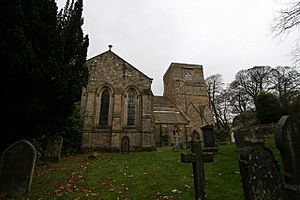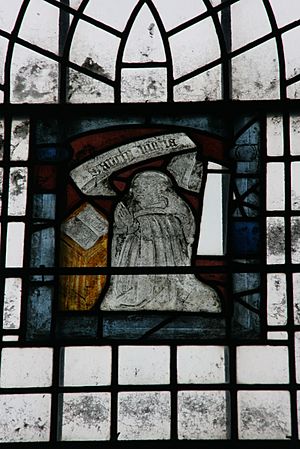Blanchland Abbey facts for kids
Blanchland Abbey is an old monastery located in the village of Blanchland, in Northumberland, England. It was first built in 1165 by a man named Walter de Bolbec II. At first, it was a "priory" for a group of monks called the Premonstratensians. This means it was a smaller monastery connected to a bigger one, Croxton Abbey. Later, in the late 1200s, it became a full "abbey."
Today, parts of the old abbey are still standing. The building that used to be the Abbot's house (where the head monk lived) is now a hotel called The Lord Crewe Arms Hotel. This building is very important, listed as a Grade II* building. The entire abbey site is also a Scheduled Ancient Monument, which means it's a protected historical place.
Abbey Under Attack: The Anglo-Scottish Wars
During the Anglo-Scottish wars, which were conflicts between England and Scotland, Blanchland Abbey faced danger. The farms connected to the abbey were often attacked and robbed. This happened especially in 1327. However, the abbey itself seemed to avoid damage.
There's a famous story about one of these raids. The monks at the abbey prayed for protection. Suddenly, a thick mist appeared, hiding the valley and the monastery from the Scottish raiders. The raiders passed by without seeing it. But then, the monks, happy they were safe, rang the abbey bells to tell everyone in the valley. The Scottish invaders heard the bells, turned back, and sadly, they ransacked the monastery.
The Abbey's End and New Beginnings
Blanchland Abbey was officially closed down in 1539. This was part of a big event in English history called the Dissolution of the Monasteries. After it closed, the land and buildings were given to the Bellow and Broxholm families. Later, the Radclyffe family owned it, and then it passed to Nicholas Forster through marriage.
Part of the abbey church was changed and kept to be used as the local church for the village. The old house where the Abbot lived became a manor house, a large country home. In 1612, Sir Claudius Forster, a important local official, lived there.
In 1701, the estate changed hands again. It went to Dorothy, who was married to Nathaniel Crew, 3rd Baron Crew, a powerful bishop. It also went to Thomas Forster, the son of Dorothy's sister. The estate had many debts. Lord Crew bought all the Forster properties, including Blanchland, in 1704. This helped pay off the debts. The Forster family's connection to Blanchland ended partly because Thomas Forster was involved in a rebellion in 1715.
When Lord Crew died in 1721, he left all his properties to be managed by a trust. This trust, called Lord Crewe's Charity, uses the money for good causes.
Today, the abbey's old gatehouse is still standing. Many of the stone houses around the village square were built using stones from the old monastery. The manor house, which was once the Abbot's home, became an inn called the Lord Crewe Arms in the 1720s, and it still is today.



